
Monogram 1/48 Harrier GR.1
| KIT #: | 5420 |
| PRICE: | $9.99 'used' |
| DECALS: | Four options |
| REVIEWER: | Pablo Calcaterra |
| NOTES: | My 1/48 tribute to the Matchbox Harrier I built in the late 70s. |

| HISTORY |
The 50s and 60s saw a very fast paced development in military aviation that was spurred by the Cold War. Looking for a tactical defense fighter the US, France, Germany and the UK embarked in individual and competing projects to develop a vertical take off and landing plane. Outstanding projects (that never made it to operational squadrons though) were the Convair XFY-1 Pogo, Ryan X-13 Vertijet, Short SC.1 XG900, Balzac V, VFW VAK-191B, Mirage III-V, Dornier Do 31 E-3 and the SNECMA C.450.
Enter Michel Wibault in the mid 50s. This little known aircraft designer had a workable solution that he developed while working at Republic Aviation in the US where he had migrated from France at the beginning of WWII. His concept of vectored thrust nozzles was rejected both in France and in the US but not giving up he presented his ideas in 1956 to Colonel John Driscoll of NAATO Mutual Weapons Development Program based in Paris. Having raised Driscoll’s interest the information about Wibault’s solution was passed on to Bristol Aero Engines in Britain. Instead of using multiple engines (rotating or not) the single engine plus vectored nozzles saved considerable weight and difficulties. Thus Sir Stanley Hooker hired Michel Wibault as a consultant on the project. BE.52 was thus born. The concept was patented in January 1957 under Wibault’s and Gordon Lewis’ names. Regretfully Wibault passed away a few weeks after the patent was granted and was never able to see his brainchild converted into one of the most famous war planes ever. It is my opinion that he is has never been given enough credit for this breakthrough with which probably the Harrier would never have seen the light of day.
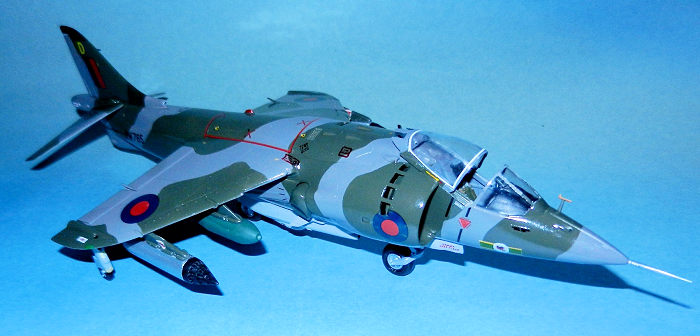 BE52 was followed by the better
BE53 and when the British aviation industry was hit by their Government decision
to cancel most of their projects (as missiles were going to rule the air…)
Hawker decided to work a new project around Bristol’s engine. The immortal Sir
Sidney Camm took the idea for Hawker Siddeley. Working in Hawker’s Project
Office Ralph Hooker designed the P.1127. His idea was to use 4 and not just 2
nozzles to direct the gasses from the single engine. With water injection to
increase the thrust and make it more attractive to the Military the refined
P.1127 had now an engine called BE53/2. This plane finally looked very similar
to the Harrier.
BE52 was followed by the better
BE53 and when the British aviation industry was hit by their Government decision
to cancel most of their projects (as missiles were going to rule the air…)
Hawker decided to work a new project around Bristol’s engine. The immortal Sir
Sidney Camm took the idea for Hawker Siddeley. Working in Hawker’s Project
Office Ralph Hooker designed the P.1127. His idea was to use 4 and not just 2
nozzles to direct the gasses from the single engine. With water injection to
increase the thrust and make it more attractive to the Military the refined
P.1127 had now an engine called BE53/2. This plane finally looked very similar
to the Harrier.
In March 1958 the airplane was presented to the MWDP and received such an enthusiastic reception that more funds were allocated to the project. In 1959 the British Government sent a request to Hawker to have the radical VTOL plane ready for service by 1965. The engine was now called Pegasus. The first contract came in 1960 and on October 21 of that year the first tethered flight of P.1127 took place. With some little issues fixed the first free hovering flights took place almost a month later.
First normal fights took place at RAE Bedford in March 13, 1961. With a second prototype built the first transitional flight took place on September 12, 1961 with Bill Bedford at the commands. With four more prototypes built, many hours under their belts and several modifications to the design of the plane itself (plus a more powerful Pegasus 5) the next plane in the development history of the Harrier was born: the Kestrel.
Several political changes happened
around that time with threatened the life and development of the Kestrel.
Luckily 9 Kestrels were ordered to continue the evaluation and development of
the technology. These were for the Tripartite Evaluation Squadron made up of US
(Navy, Army, Air Force), RAF and Luftwaffe pilots. This Squadron was formed on
April 1 1965 at RAF West Raynham. The ten pilots who flew with the Kestrel
Evaluation Squadron were Sqn Ldr Fred Trowern; Lt Col Lou Solt; Wg Cdr David
Scrimgeour; Col Gerhard Barkhorn (the famous WWII German ace with 301 kills);
FIt Lt David Edmondston, Capt Volke Suhr; Maj Al Johnson; Maj J K Campbell; Lt
Cdr Jim Tyson and Flt Lt ‘Porky’ Munro. The TES was disbanded in November 1965
with 1,367 sorties completed and several technical and tactical issues and
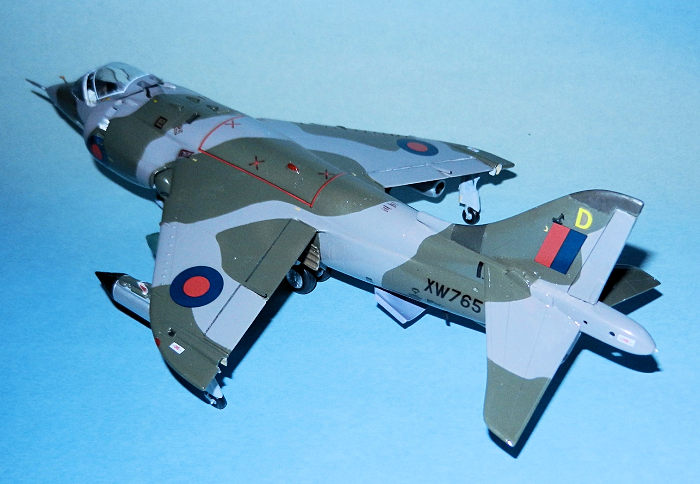 problems found and overcome. One of those derived in the development of the MEXE
pad that allowed the plane to operate from unprepared fields without the risk of
ingesting foreign objects lifted by the powerful jet blasts.
problems found and overcome. One of those derived in the development of the MEXE
pad that allowed the plane to operate from unprepared fields without the risk of
ingesting foreign objects lifted by the powerful jet blasts.
No further interest came from the Luftwaffe but the US Marines adopted the Harrier as the AV-8B later on.
When project P1154 along with TSR2 were cancelled and with the Royal Navy deciding to deploy Phantoms in the carriers Hawker Siddeley was able to focus on the final changes to the Kestrel. These included among others extended wings with longer curved tips, a Pegasus 6 with 19,000 lb of thrust, five hard points and several refinements from the Kestrel and the now deceased P.1154. In April 1965 the MoA issued a contract for 6 development airplanes. Bill Bedford flew the new plane (XV276) for the first time on August 31 1966.
One of the most important issues to be fixed was the fact that the plane had to be managed to stay facing the wind at all times during landing or take off. That meant that a little swing in either direction would then give more lift to one wing than the other and the plane could flip over and crash. To help the pilot understanding the wind direction in this critical phase a small and simple vane was added in front of the windshield.
A contract for 60 planes followed in January 1967. The Harrier GR1 was born.
1 Sqn was earmarked as the 1st Harrier Squadron and started to receive the revolutionary plane in 1969. To mark the 50th anniversary of the crossing of the Atlantic by John Alcock and Arthur Whitten Brown the Daily Mail Transatlantic Air Race took place in May 1969. Sqn Ldr. Tom Lecky-Thompson started the race from the top of the Post Office tower in London, got to his Harrier XV741 parked at a disused coal yard close to London’s St Pancras station, refuelled four times from Victor tankers over the Atlantic and reached a demolished factory place by the East River in New York from where he jumped onto another motorcycle to rush to the top of the Empire State Building. A total of 6 hours, 11 minutes and 57 seconds gave the Harrier the victory on this leg (it was defeated on the return one by issues with the weather).
Having passed on their Hunters 1 Sqn became operational with the Harrier on January 1 1970 under the command of Wing Commander Ken Hayr.
In October 1970 the first 2 seat Harriers (T2) were delivered and the critical No. 233 OCU was formed.
Next it was the turn of 4 Sqn to receive their Harriers followed by 20 Sqn. RAF Wildenrath in Germany received these 2 Squadrons along with 3 Squadron in 1972. The 3 Squadrons based in Germany were considered close air support and flew incessantly to practice attacks on the potential invaders from the Warsaw Pact forces. Pilots in the Wing were not expected to survive more than a few days due to the expected antiaircraft defenses of the Soviet block forces. Because of the VTOL capabilities of the Harrier these were periodically dispersed to the country side where specially prepared field airfields were readied. Preferred armament to attack the enemy was the BL755 Cluster bombs. (One of those actions by a 3 Sqn Harrier GR1 is represented in the box art of the Matchbox kit. And it is this box art that called my attention in the late 70s and let me to purchase the now classic 1/72 model plane)
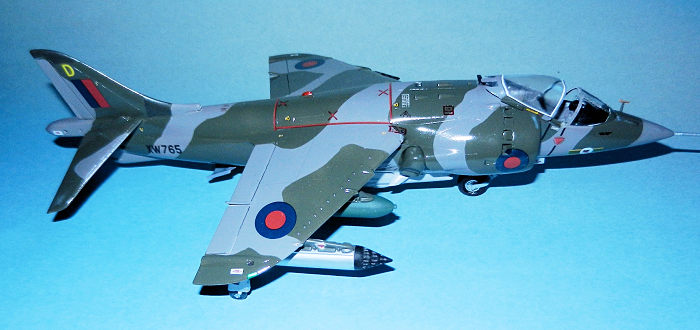 Going back to the historical write
up…in November 1975 a flight of Harriers GR1 were deployed to Belize when
Honduras was threatening to walk into that territory that was considered part of
their country.
Going back to the historical write
up…in November 1975 a flight of Harriers GR1 were deployed to Belize when
Honduras was threatening to walk into that territory that was considered part of
their country.
With new engines and the LRMTS on the re designed nose of the plane (making it for me much less appealing than the pointy GR1 one) the GR3 version was born. All GR1s were converted to the new standard by 1975.
Going back to the Harrier GR1 hereby depicted it was converted to the GR3 standard. On March 12 1980 and when based at RAF Gutersloh it crashed during a work up flight in Wales for the upcoming Maple Leaf exercise to take place in Canada later. Flt Lt Paul Barton saw a large bird in front of his plane and with no time to react noticed the impact. The engine started to make strange noises. Climbing immediately to check the engine Barton saw the RPM decreasing though he had not touched the throttle. Having gained around 1,200 ft Barton dropped the external fuel tanks over open fields. He diagnosed that the engine had surged and the protocol to fix the problem is to shut it down and re lit it. He succeeded in starting the engine again but by now he was too low to regain control of the plane as enough power had not been attained. Paul Barton ejected from XW765 only 2 seconds before I crashed on the ground 2 ¾ miles SSE of Lampeter, Wales. The pilot landed unhurt and was rescued by a RAF Sea King from RAF Brawdy. It was later found that a buzzard could have been the bird that was ingested by the engine (their average weight is approx. 21 lb). Though there was no significant damage to the engine the ingestion had created a disturbance to the air flow to the engine and thus this surged. Time elapsed between the hit and the crash was just 45 seconds. Flt Lt Paul Barton would later on fly on 801 Sqn (RN) as an exchange pilot and shot down the first Argentine plane of the war when he downed Carlos Perona’s Mirage IIIEA (see https://modelingmadness.com/review/mod/fr/calm3e.htm). Having survived the war Flt Lt Paul Richard Barton was made member of the MBE in 2009.
| THE KIT |
The classic Monogram 1/48 kit has been around since 1981. Even though it has raised panel lines (typical of the era) the finesse and accuracy is still a great asset after so many years. And beats hands down the Airfix GR3 version. For will find Scott’s preview here. There is little flash in the pieces, external loads is limited to missiles, some Snake Eye bombs and ADEN gun pods. You can build a AV-8B Harrier from the Marines or a 4 Sqn RAF GR1.
Decals are quite good though some stencils are missing.
| CONSTRUCTION |
When I purchased the kit on eBay several years ago my idea was to kit-bash it with the Airfix GR3 like many others have done. That is to say use the nose of the GR3 and attach it with some surgery to the Monogram kit. The idea was to build a 1982 South Atlantic RAF Harrier.
 Several
ideas crossed my mind in terms of what to do with the unused Airfix Harrier
(minus nose) and a discarded GR1 Monogram pointy nose. Maybe a diorama with
Peter Squire’s crashed Harrier at San Carlos. Or a Spanish Armada Matador…and
then I decided to kill the kit-bash project and build the two kits
independently. The Monogram would be a GR1 and the Airfix a GR3.
Several
ideas crossed my mind in terms of what to do with the unused Airfix Harrier
(minus nose) and a discarded GR1 Monogram pointy nose. Maybe a diorama with
Peter Squire’s crashed Harrier at San Carlos. Or a Spanish Armada Matador…and
then I decided to kill the kit-bash project and build the two kits
independently. The Monogram would be a GR1 and the Airfix a GR3.
These 2 planes were tackled at the same time as most of the colours are the same. For the GR1 I decided to go with a “glorified” or “tribute” version of the Matchbox GR1 in 1/72 that had inspired me more than 30 years ago. This kit I had traded with a friend before the 1982 war but this year I found it on eBay minus decals and purchased it for U$S 7. And it turned out it was the original 1972 issue! I found a picture of the Matchbox decals on line, printed them on decal paper and used then on the unpainted model (as I wanted it to look like the one I had so many years ago).
First thing (just to complicate my life, like always) was to re-scribe all the panel lines and eliminate the raised panel lines.
The nose wheel well was painted in white, assembled and lead ballast was added to the nose. The instrument panel is a decal I made using a picture of the actual thing I found on line. The cockpit was painted using the colours indicated by the SHAR Special Interest Group of the IPMS UK (Dark Sea Grey).
The auxiliary doors on the top portion of the air intakes are open when the Harriers are on the ground. Thus I had to cut out 4 on each side and create them using Evergreen plastic. They were attached in a dropped position at the end of the building process.
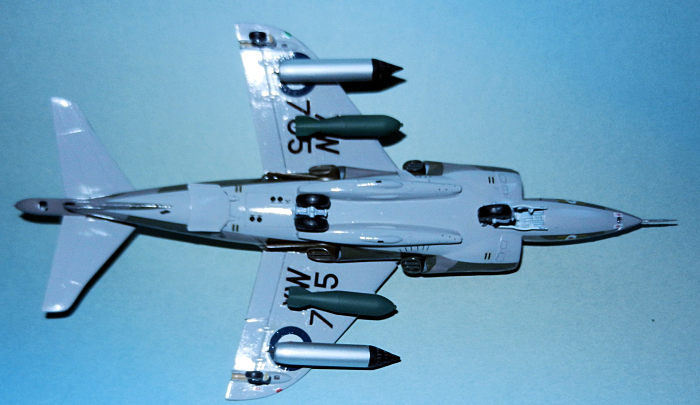 There are no
special areas that require attention except for some less than satisfactory gaps
in the union of the top fuselage/wings section and the front of the insert for
the airbrake. A bit more was required in the wing/fuselage union under the
wings.
There are no
special areas that require attention except for some less than satisfactory gaps
in the union of the top fuselage/wings section and the front of the insert for
the airbrake. A bit more was required in the wing/fuselage union under the
wings.
One of the omissions of the Monogram kit is the camera port on the left hand side of the nose and the bulges on top of the fuselage close to the tail sealing plates. These I have scratchbuilt with Evergreen from different thicknesses.
The gun pods are missing some vents (that I drilled) and plates (more Evergreen). 1,000 lb British bombs came from a couple of Hobbycraft Argentinean Skyhawks. Rocket launchers are from the Airfix Harrier.
Building the plane was much easier and took less time than re-engraving the panel lines.
After giving the kit a nice wash with mild soap the Harrier was ready for painting.
| COLORS & MARKINGS |
For the first time ever I used Vallejo grey primer. (I had used the ModelMaster Acryl one in the past). WHAT A DIFFERENCE! This premier glued itself to the plastic…like it was part of the plastic! I am never again using the ModelMaster one.
Canopy and windshield frames were masked and painted black followed by the cammo colours.
First I painted the undersides with Vallejo 70.989. After the paint dried and it was masked I painted the top surface with grey (Vallejo 991-159). Using the Airfix scale plans, taking them to 1/48 and cutting out the grey areas I used masking tape to cover this colour. The green (Vallejo 893-095) was then safely applied with the airbrush.
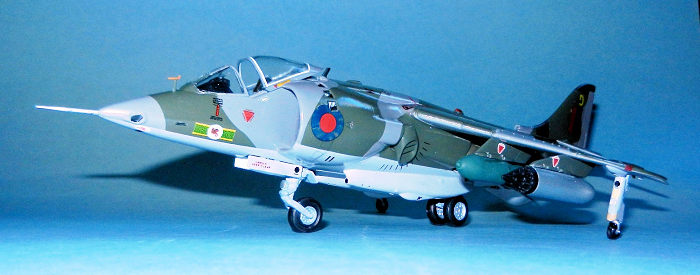 Airbrake
interior was painted ModelMaster Acryl 4754. Rocket launchers were painted first
in black (tips) and then with Vallejo Aluminum (rest of the body…and again what
a difference in terms of density when compared to ModelMaster!) The bombs were
painted Euro Green.
Airbrake
interior was painted ModelMaster Acryl 4754. Rocket launchers were painted first
in black (tips) and then with Vallejo Aluminum (rest of the body…and again what
a difference in terms of density when compared to ModelMaster!) The bombs were
painted Euro Green.
I carefully removed the masking tape and not a single dot of paint was peeled off. None. This is completely different from what I have ever experienced either with Humbrol or ModelMaster. These Vallejo Primer and paints are fantastic! From now on, as I run out of ModelMaster I will purchase Vallejo.
With the entire landing gear system glued in place I proceeded to give the Harrier roughly 3 coats of Future (how I hate this part of the process, the dread of finding the clear substance running down a side like a tear…)
Everything was now ready for the decals.
Because I wanted to represent the Matchbox kit I put myself again into a corner. I had to print the serial numbers for under the wings and back of fuselage – XW765, the badge for 3 Sqn (after searching on the web many times for one that was clear enough but also would represent the one on the actual plane and not one of the several variations), several stencils (copied from the Airfix kit: angle of the front exhaust nozzle, fire warning red rectangles, warning for the tail, wingtips and nose exhaust, multiple warnings around the nose and fuselage) and the yellow D for the tail and the outriggers (which was printed on white decal sheet after testing several background colours that would match the paint). The canopy opening system came from one of the two available in the Airfix decal sheet,
The Monogram decals received a coat of decal protector spray from Testors (just in case they would self destroy when touching the water due to their age). But they reacted very well to Set and Sol solutions. Once these were dry I was ready to finish my “large Matchbox” by first spraying a light coat of Future to seal the decals.
| FINAL CONSTRUCTION |
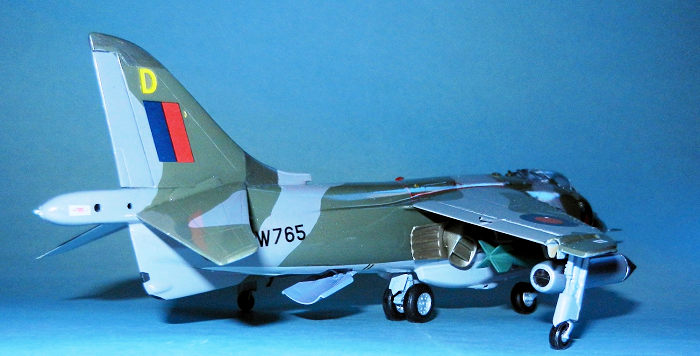 I
started to add the details for the bottom fuselage from the center and
moving outwards: landing gear doors, airbrake, bombs and rocket launchers.
For the top I scratchbuilt the temperature probe on the tail, the direction
vane (painted in orange) and a few antennas. The nose camera was painted in
black.
I
started to add the details for the bottom fuselage from the center and
moving outwards: landing gear doors, airbrake, bombs and rocket launchers.
For the top I scratchbuilt the temperature probe on the tail, the direction
vane (painted in orange) and a few antennas. The nose camera was painted in
black.
The navigation/formation lights were painted in 2 steps: Vallejo Aluminum followed by Clear Red and Green from ModelMaster, silver for the tail one.
The gunsight was added, seat attached (not correct for the RAF version I understand but that is what I had in hand), nose pitot installed and finally the canopy glued open (with fine strips of white decal paper around the edge of the Plexiglas).
| CONCLUSIONS |
I am quite satisfied with the end result (read the PS below). Of course I am not a Harrier expert and there must be lots of things that are not perfect. But for the untrained eye (like mine!) my “large Matchbox” tribute is quite decent. And now I have my 1/72 unpainted Matchbox with my self made decals sitting beside the 1/48 Monogram with all the whistles and details missing in the small version kit.
PS: After finishing the plane I was able to find the actual picture of D among all the ones I had downloaded (could not find it when I needed it to apply the decals) and realized that I had made some mistakes: the yellow D should have been placed further forward on the tail, the 3 Sqn badge should probably sit 2 mm higher up on the nose and the white warning stencils on the tail are in reality located below and not behind the round grid. Ah! And most importantly…the picture shows that D was not painted in Gloss but in a dull finish…Now we know that during the early deployments in Germany the Harriers were painted with a Gloss coat. Had XW765 the D on the tail in 1972 in Germany or was it added when the plane received the dull finishing coat? Dunno…but I wanted my GR1 to be one of the ones in Germany and gloss finished. So either I had to remove the Future to peel off the Ds (just in case) or leave it as it was (hoping that the D was already in use during the “glossy period”). This is what I decided to do.
Then on the picture I was able to see that the top and front of the tail were painted in a dark metal/aluminum colour (which is hinted also in the Matchbox paint scheme). So carefully I masked the area, sanded off the Future (to prevent the new coat of paint from cracking due to the surface tension) and with a brush I painted a mix of black and burnt metal.
Done! Enough! Finito! The GR1 was done and over.
I cannot finish this review without thanking the help of Nick Greenall of the Harrier SIG of the IMPS UK. Thanks for your patience and support Nick!
| REFERENCES |
24
February 2020 Copyright ModelingMadness.com
Thanks to me for getting this one on sale. If you would like your product reviewed fairly and fairly quickly, please
contact
the editor
or see other details in the
Note to
Contributors.
Back to the Main Page
Back to the Review
Index Page
Back to the Previews Index Page